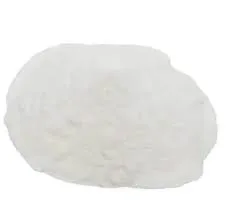
nov. . 06, 2024 06:17 Back to list
Manufacturing Techniques for Redispersible Polymer Powders in the Chemical Industry
The Manufacturing Process of Redispersible Polymer Powder
Redispersible polymer powder (RDP) has become an essential ingredient in various construction and building materials, enhancing properties such as adhesion, flexibility, and water resistance. The manufacturing process of RDP is a complex procedure that transforms polymer emulsions into a fine, dry powder form that can be re-dispersed in water. This article provides an overview of the manufacturing process, focusing on the key steps involved and their significance.
Step 1 Polymer Emulsion Preparation
The first step in manufacturing RDP is to create a stable polymer emulsion. This is typically achieved through a process known as emulsion polymerization, where monomers (such as vinyl acetate, ethylene, or styrene) are polymerized in the presence of water and surfactants. The choice of monomers and additives directly influences the properties of the resulting polymer.
During emulsion polymerization, a monomer mixture is introduced into a reaction vessel containing water and emulsifiers. Under controlled temperature and stirring conditions, initiators are added to start the polymerization process. The polymer chains grow, encapsulated in micelles formed by surfactants, resulting in a stable latex emulsion. The resulting emulsion contains water (typically 40-60% by weight) and a high concentration of solid polymers.
Step 2 Drying Process
Once the polymer emulsion has been prepared, the next step is to convert it into a dry powder form. This is done through a drying process, which can involve several techniques depending on the desired properties of the final product. Common drying methods include spray drying, drum drying, and freeze-drying.
- Spray Drying In this method, the emulsion is atomized into fine droplets in a heated chamber. The heat causes the water to evaporate rapidly, leaving behind dry polymer particles. This process is widely used due to its efficiency and ability to produce uniform powder sizes.
- Drum Drying Alternatively, the emulsion can be spread over heated drums, where the water evaporates as the emulsion dries. The solid polymer is then scraped off, resulting in dry sheets that can be ground into powder.
- Freeze-Drying This method involves freezing the emulsion and subsequently subjecting it to a vacuum that removes the ice through sublimation. While freeze-drying is less common due to its higher cost and longer processing time, it can preserve the properties of sensitive polymers.
redispersible polymer powder manufacturing process

Step 3 Milling and Sieving
After drying, the resulting polymer is often in a granular or flake form. To achieve the desired particle size and distribution, the dried material undergoes milling, where it is ground into a fine powder. This process may involve the use of hammer mills or air classifiers, which allow for control over the powder’s fineness.
Following milling, sieving is performed to remove any oversized particles and ensure uniformity. The final particle size is critical, as it affects the re-dispersibility of the powder in water, impacting the overall performance in end-use applications.
Step 4 Additive Incorporation
To enhance the properties of the RDP, various additives may be incorporated during the manufacturing process. These can include anti-foaming agents, stabilizers, or pigments, depending on the specific requirements of the application. The incorporation of these additives is crucial for tailoring the RDP to meet customer specifications and industry standards.
Step 5 Quality Control
The final step in the manufacturing process is rigorous quality control to ensure the consistency and performance of the RDP. This typically involves various tests, including particle size analysis, moisture content determination, and re-dispersibility assessments. Ensuring high quality in RDP helps maintain the reliability of construction materials and end products.
Conclusion
The manufacturing process of redispersible polymer powder is multifaceted, involving stages from emulsion preparation to drying, milling, and quality control. Each step is crucial in determining the final properties of the product, affecting its performance in applications such as tile adhesives, thermoplastics, and exterior insulation systems. As the demand for high-performance building materials increases, the production of RDP continues to evolve, incorporating advancements in technology and materials science to meet the needs of the industry.
-
Versatile Hpmc Uses in Different Industries
NewsJun.19,2025
-
Redispersible Powder's Role in Enhancing Durability of Construction Products
NewsJun.19,2025
-
Hydroxyethyl Cellulose Applications Driving Green Industrial Processes
NewsJun.19,2025
-
Exploring Different Redispersible Polymer Powder
NewsJun.19,2025
-
Choosing the Right Mortar Bonding Agent
NewsJun.19,2025
-
Applications and Significance of China Hpmc in Modern Industries
NewsJun.19,2025







